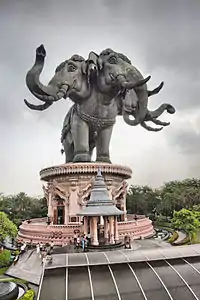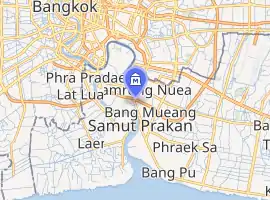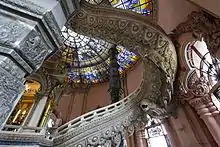Erawan Museum
Erawan Museum (Thai: พิพิธภัณฑ์ช้างเอราวัณ) is a museum in Samut Prakan Province, Thailand. It is well known for its giant three-headed elephant art display. The three storeys inside the elephant contain antiquities and priceless collections of ancient religious objects belonging to Khun Lek Viriyapant who is the museum owner.
พิพิธภัณฑ์ช้างเอราวัณ | |
 | |

| |
| Location | Sukhumvit Road, Samut Prakan, Thailand |
|---|---|
| Website | erawan-museum.com |
History of The Erawan Museum
Erawan Museum in Thailand is an important model of sculpture. The Erawan Museum is the door opening to the heritage of Thai culture. With a wide range of architectural symbols combined with fine arts and craftsmanship, structural layout and natural environment that integrate harmoniously, the Erawan Museum creates a kind of atmosphere that induces visitors to perceive and appreciate the continuity of history, cultures, religions, arts and customs of faith from past to present. It is located on an area of 12 acres by Thonburi Autumotive Assembly Plant Co., Ltd. The museum is built from the inspiration of Mr. Lek Viriyaphant, creator of the Ancient Siam and Sanctuary of Truth Pattaya City, Chonburi to provide a storage place for artifacts and heritage conservation areas and to continue to preserve traced artwork.
Structure of The Erawan Museum

The massive three headed elephant made of bronze weighs 250 tons, is 29 metres high, 39 metres long and stands on a 15-meter-high (49 ft) pedestal. The inside of the museum is modeled after the Hindu representation of the universe, which consists of the underworld (1st floor), earth (2nd floor) and Heaven (top floor). The lower two floors are located inside the pedestal while the top floor is located in the belly of the elephant. ฿400 entrance fee as of 2019.
Exhibit space
The first floor represents the underworld and contains a collection of Chinese vases from the Ming and Qing dynasties and a history of the museum's construction as photographs and wall placards.
The second floor representing the earth (or human world) houses more precious antiques and arts including ceramics and European pottery. The hall features a statue of Guanyin, the Chinese Goddess with a thousand arms.
The top floor represents the Travatimsa Heaven, which is located on top of Mount Meru in Buddhist cosmology. On display are relics of the Buddha and very old Buddha statues from several eras including Lopburi, Ayutthaya, Lanna and Rattanakosin. The walls are decorated with paintings depicting the cosmos.
